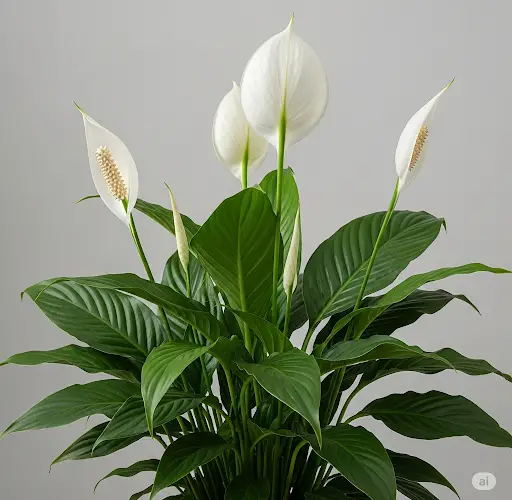Spathiphyllum, commonly known as peace lily, is a favorite among indoor plant lovers for its graceful white blooms and glossy green foliage. But even the healthiest-looking peace lily can sometimes refuse to flower. The solution? A surprisingly simple trick: one spoonful of a natural booster that can spark abundant blooming—not just in Spathiphyllum, but in virtually any flowering houseplant.
This method is low-cost, easy to prepare, and safe for your plants. It works by delivering a carefully balanced dose of nutrients tailored for flowering—especially useful during the growing and blooming season when your plant’s energy needs are at their highest.
Why Peace Lilies Stop Blooming
While peace lilies are considered relatively low-maintenance, getting them to bloom regularly can be a challenge. Common reasons they fail to flower include:
-
Lack of phosphorus and potassium
-
Low light levels
-
Compacted or nutrient-poor soil
-
Overwatering or poor drainage
-
Absence of a rest period in winter
Peace lilies naturally flower in response to proper lighting and nutrition. That’s where this natural spoonful formula comes in—it replenishes nutrients, boosts plant metabolism, and encourages bud formation.
The One-Spoon Bloom Booster: What’s Inside
This homemade tonic features simple kitchen ingredients that are rich in the nutrients flowering plants crave. The core formula includes:
-
1 teaspoon of dry yeast
-
1 tablespoon of sugar
-
1 liter of warm, non-chlorinated water
Yeast is rich in B-vitamins, enzymes, and natural growth stimulants. Sugar provides quick energy and also feeds beneficial soil microbes, which improve nutrient uptake in the root zone.
How to Prepare the Flowering Tonic
-
Warm the water slightly (not hot—around 30–35°C / 86–95°F is ideal).
-
In a cup, dissolve the sugar in a small portion of the water.
-
Add the dry yeast and stir well.
-
Let the mixture rest for 2 hours in a warm place to activate the yeast.
-
Once bubbles appear, dilute the solution into the rest of the water.
This creates a mild, nutrient-rich liquid that can be measured by the spoonful and applied to your plants.
How to Apply It to Your Peace Lily
-
Dose: Use 1 tablespoon per medium-sized potted plant. For smaller plants, use a teaspoon.
-
Method: Pour directly at the base of the plant, avoiding the leaves.
-
Frequency: Apply once every 2–3 weeks during spring and summer. Reduce or stop feeding in winter.
Make sure the soil is slightly moist before applying the tonic. This helps ensure nutrients are absorbed more evenly and avoids root burn.
Results to Expect
Within a few days to a week, you may notice:
-
Firmer, glossier leaves
-
More visible flower buds beginning to emerge
-
An overall healthier, more upright plant posture
-
Reduction in yellowing or drooping leaves
Peace lilies often respond to this treatment by producing multiple flower stalks, and the blooms tend to last longer and appear more vibrant.
Works on Other Flowering Houseplants Too
This spoonful treatment isn’t exclusive to Spathiphyllum. It’s effective for:
-
Anthuriums
-
Geraniums
-
African violets
-
Begonias
-
Miniature roses
-
Jasmine
-
Hibiscus
Each of these plants benefits from the potassium, phosphorus, and micro-nutrients found in the yeast-based tonic.
Additional Care Tips for More Flowers
While feeding helps, blooming also depends on overall care. Here are a few extra tips to boost flowering:
-
Light: Peace lilies prefer bright, indirect sunlight. Too much shade limits blooming.
-
Humidity: These tropical plants love humid conditions. Mist them regularly or use a pebble tray.
-
Watering: Keep the soil consistently moist but never soggy. Let the top inch dry out slightly before watering again.
-
Repotting: If your plant hasn’t bloomed in over a year, check if it’s root-bound. A slightly larger pot with fresh soil can help.
-
Clean the leaves: Dusty foliage hinders photosynthesis. Wipe leaves gently with a damp cloth once a month.
A Natural Approach to Continuous Blooms
Using a spoonful of this natural blooming booster can make a noticeable difference—not just in peace lilies but across your entire indoor garden. By enhancing soil microbial life and giving plants the specific nutrients they need to flower, you help them thrive without relying on synthetic fertilizers.
Whether your goal is more frequent blooms, healthier leaves, or a livelier indoor environment, this method is a simple and reliable way to achieve it. Try this once every few weeks, and your plants will respond with lush greenery and vibrant flowers that last for months.



